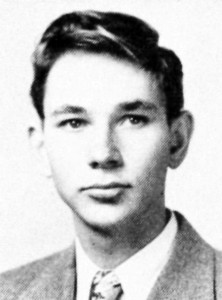Larry Lowery ’50

We covered primarily school events. As the Editor, I had a regular column which I called “Here’s the Dope.” I also did cartoons for the paper, especially sports cartoons, and other humor stuff. Once, Walt Disney invited me to be a reviewer for its new movie “Cinderella.” That was exciting!
About 6 of us from the Journalism class went to the print shop in downtown Oakland every Friday to put the “slugs” of type in the “sticks” to get the paper set up. We were taught how to use the “Linotype” machine including how to put in spaces, how to place pieces to attract the eye, how to make corrections. The people in the print shop taught us all that. We basically missed school every Friday. By senior year, we had taken all that we needed for college so we didn’t miss that much. It was more flexible in 1950! It was just great.
I particularly remember one article in the Scribe. My girlfriend at the time, Peggy Donovan, and I won the Dads’ Club Talent Show. There were “Dads’ Clubs” at every school which sponsored various events. The Talent Show was really well organized. The various high schools would compete against each other in different categories like solo, duets, bands, etc. and the winners would go on to a statewide competition. My girlfriend and I both play accordions and our performance of Liszt’s Hungarian Rhapsody won for the entire Bay Area and then for the whole state! Someone from a =San Francisco television station saw us, thought we were colorful in our lederhosen, and put us on the first colored television broadcast in the country which was beamed out of San Francisco. I have the photos of that. They couldn’t record it on film, but we have the soundtrack for it. At that time, the cameras were stationary. When we were practicing our number, the station manager said, “We can’t use the kids. Every time they hit the keys, they burn our tubes.” The reflection apparently caught the light in a certain way and the result was the light tubes burned out! The prop man got the brilliant idea of powdering our accordions with face power, so every time we pushed the bellows, there was a little puff of powder. It was very funny. I was in 12th grade. Peggy went on to become a professor of music at Sonoma State University and I became a professor of Science Education at UC Berkeley.
The post-war years, when I was in high school, were a peaceful era. The war was behind us and the world was changing. GI houses were going up to house the returning soldiers and their new families. There was a big boom of new kids in the schools. It was a great time in the country and at Oakland Tech. The classes were wonderful. The teachers were great. Society felt really good. We weren’t a divided country. There was a good feeling in those years compared to now when the country feels pretty fragmented.
A lot of blacks had come up from the South to work in Oakland shipyards during the war and they after the war and established themselves in the Bay Area. There was a fair amount of diversity at Tech when I was there and it seemed like no one really cared about different groups being different. Kids were on different tracks though. It was mostly white kids in college prep. A lot of the black kids from the South hadn’t gotten the educational preparation that we had enjoyed and that played out in high school. I think a lot of them took the shop and business classes, but in terms of mixing together, we did somewhat. It really was an interesting time. I think the teachers were mostly white.
I remember Clint Eastwood was always in the auto shop. I knew him a little. He loved music and since I played the accordion, we talked a little about music. He played with local bands at night. He really was already out in the adult world. He wasn’t a big heartthrob then. He was pretty much a loner. He didn’t come to school events, but he wrote an autobiography and there is a section in it on Tech.
As far as other teachers, I remember my geometry teacher, Mr. Max Yulich. I loved him. He could stand with his back to the blackboard, facing us, and draw a perfect circle on it every time. Just perfect!
We always had lunch on the front lawn. Every group had it own place it would go to. We weren’t allowed to leave campus. Later on, they could get a hot dog across the street. There was a cafeteria, but my friends and I always brought bag lunches.
Those were happy times!
[With the Lawrence Hall of Science, Larry Lowery developed a nationally popular hands-on science curriculum called FOSS (Full Option Science System) and two acclaimed math programs- FAMILY MATH and EQUALS. In addition, he is the nation’s foremost expert on “Big Little Books” (small, compact books designed with a captioned illustration opposite each page of text) that were published from the 1930s to the 1960s, were extremely popular among young readers, and are today collectible.]
